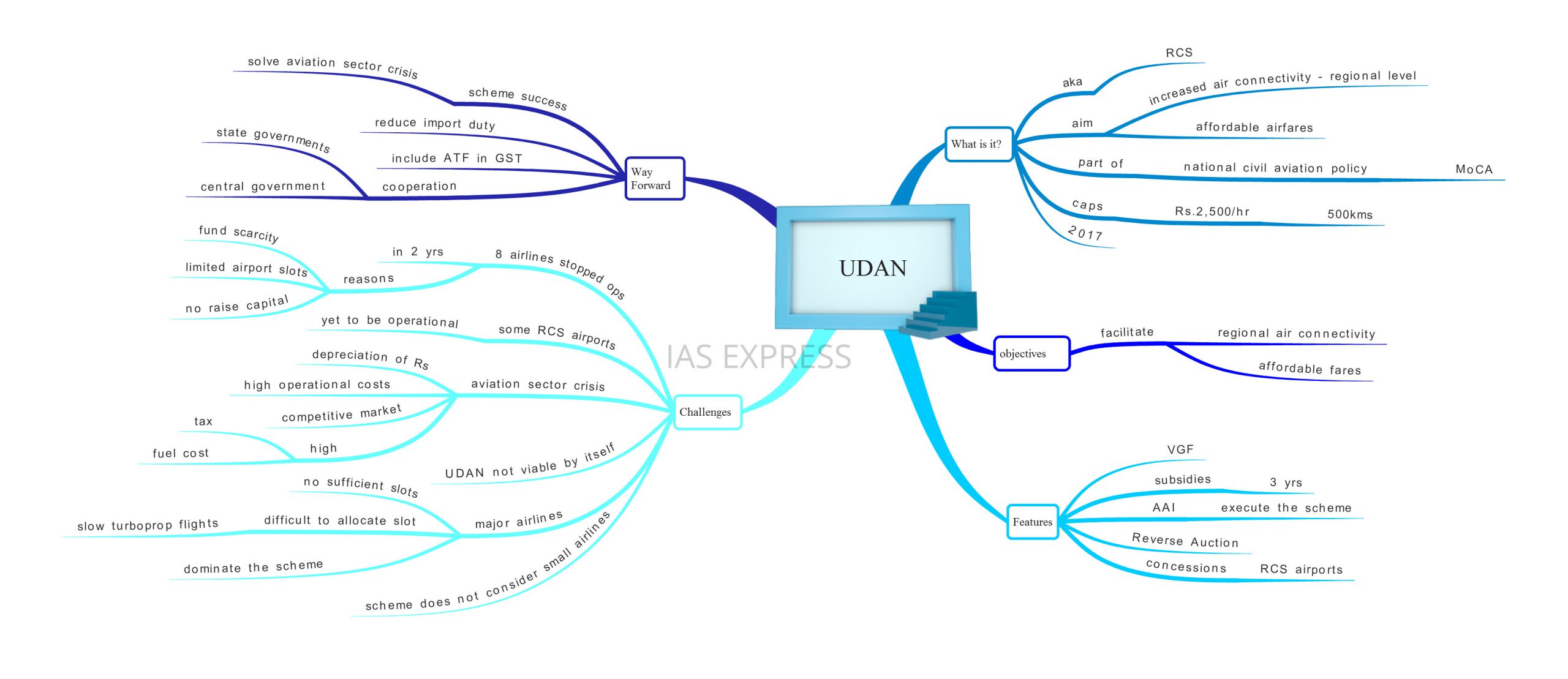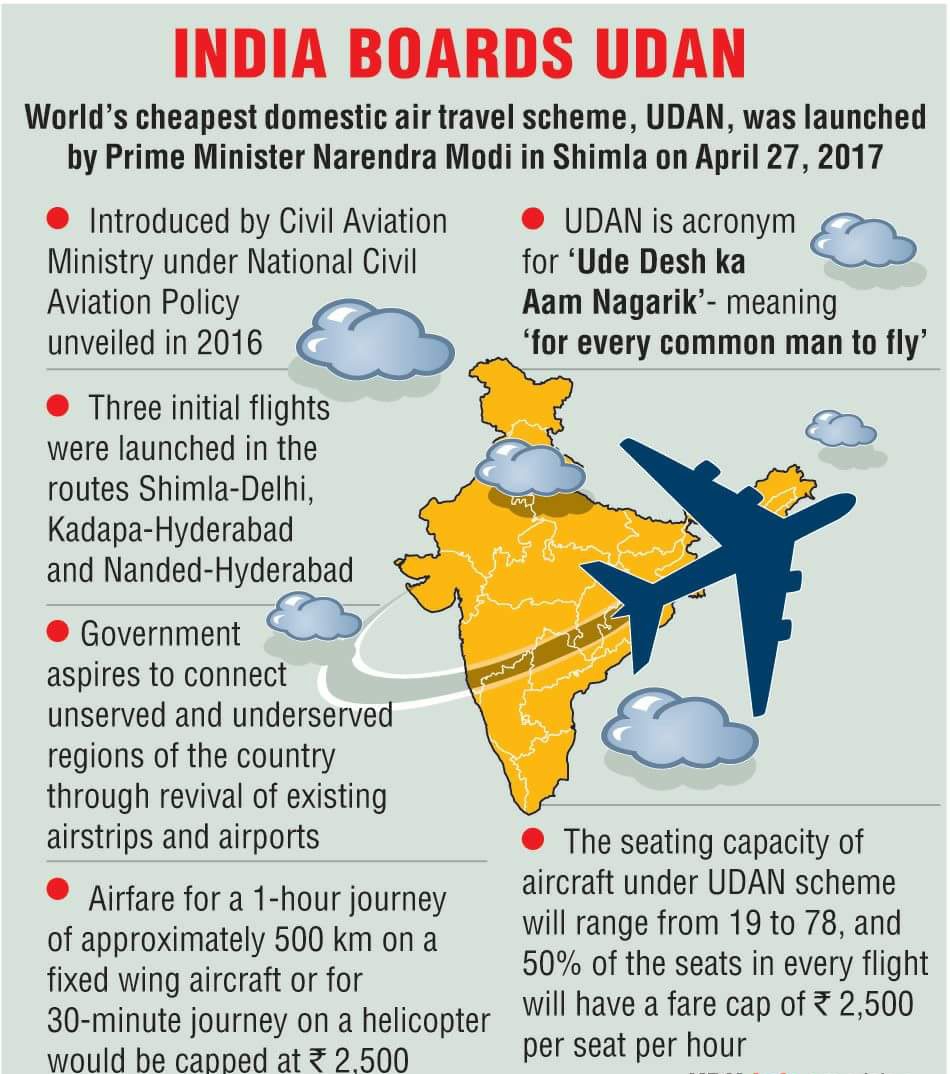UDAN Scheme – Critical Analysis

From Current Affairs Notes for UPSC » Editorials & In-depths » This topic
IAS EXPRESS Vs UPSC Prelims 2024: 85+ questions reflected
India’s aviation sector is contributing about 30 billion USD to India’s GDP. India is one of the fastest-growing aviation markets in the world. Nearly 90% of the aviation traffic is at the domestic level. This means that UDAN scheme or the Regional Air Connectivity Scheme is an asset to the aviation sector. However, this scheme alone cannot address the growing crisis in the aviation sector. The government must launch a viable policy to support the growth of this sector.
What is UDAN Scheme?
- “Ude Desh ka Aam Nadgrik” or the “endeavour to make common people fly” or the Regional Connectivity Scheme is a flagship scheme that seeks to ensure increased air connectivity at the domestic level and make flying affordable to all.
- It is a component of the National Civil Aviation Policy which was launched by the Ministry of Civil Aviation.
- The goal of this policy is to enhance regional connectivity through fiscal support and infrastructure development.
- The UDAN scheme puts a cap of Rs. 2,500 for 1 hour of a commercial flight that covers a distance up to 500km.
What are the objectives of this scheme?
The objectives of this scheme are as follows:
- The first and foremost objective of this scheme is to facilitate improved regional air connectivity.
- Make airfare cheap and affordable.
- This is ensured by the government by providing financial support to the air operators to reduce the gap between the cost of airline operations and the revenue obtained by the airlines while operating in these routes (Viability Gap Funding).
- This scheme seeks to connect the unconnected routes of the Indian airspace.
What are the key features of this scheme?
- Subsidy: The Government will provide subsidy to the airlines under this scheme for three years to increase the demand for the flight tickets to the new air routes.
- Funding: The government will fund the airlines in case of losses to ensure that the cap of Rs. 2,500/hour on half the seats is maintained. The subsidy amount will vary between Rs.2,350 to Rs.5, 100 based on the distance covered.
- Airport Authority of India: The Airport Authority of India is the executing agency of this scheme.
- Reverse Auction: As per the scheme, the bidding for the route will be based on the reverse auction. That is, the lowest amount of subsidy will be given the license to fly in the RCS route.
- Concessions: The airlines are encouraged to operate in the unconnected regions of India by offering them concessions.
- Easing financial burdens: The airlines are exempted from landing and other charges in the RCS airports. The RCS flights must also make 50% of their seats as RCS seats.
What are the challenges faced by this scheme?
- This scheme, launched in 2017, is at its third phase.
- Despite the subsidies, 8 regional airlines have stopped the operations in the last two years.
- The reasons include scarcity of funds, limited airport slots, inability to raise capital and also the lack of manpower.
- Air Deccan which was re-launched under this scheme had not flown since October 2018.
- The first two rounds of the RCS bidding have covered 450 routes, which includes 160 airports, helipads, and airstrips.
- However, many of these airports are yet to be operational.
- Also, the Indian Aviation Sector is facing a crisis.
- This is mainly due to the depreciation of the rupee, high operational costs, and competitive market.
- This sector is burdened by high fuel costs and state taxes.
- UDAN scheme is not viable by itself.
- The support from the state governments and improved policy mechanisms vital for this scheme to be successful.
- Furthermore, the major airlines do not have sufficient slots to connect the less-used airports.
- To add to their woes, the major airports are finding it difficult to allocate slots to the regional airlines that are flying turboprop aircraft as they take longer time to land.
- Hence, the success of this scheme is still dependent on major airlines like the SpiceJet, Air India, etc.
- These major firms operate a large portion of the RCS flights.
- This means that the UDAN scheme is not considering the growth of small and independent airlines.
Way Forward
- Necessary steps must be taken by the government to solve the aviation sector crisis for this scheme to be implemented to its fullest extent.
- Though bailout seems attractive, is not a viable solution.
- Experts believe that the reduction of the import duty may help solve the problem.
- Inclusion of ATF within the GST is a need of the hour.
- This scheme is a step in the right direction to ensure improved connectivity within India.
- However, a prudent supportive policy is essential.
- India is the fastest-growing aviation market in the world. In the year 2018 alone, India’s passengers have grown more than 16%.
- This sector also employs 76 lakh people either directly or indirectly.
- This shows that the Indian Aviation Sector has an enormous potential to grow and expand.
- However, due to the lack of viable government policies, this sector is facing a crisis.
- The Central Government, along with the state governments must take proactive measures to address and solve the issues faced by this sector for it to realize its full potential.
If you like this post, please share your feedback in the comments section below so that we will upload more posts like this.



